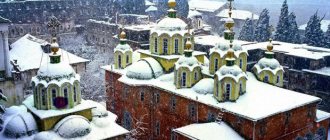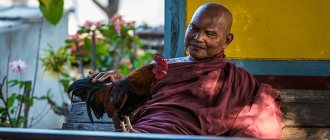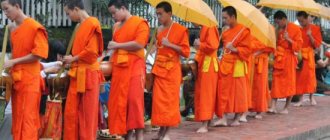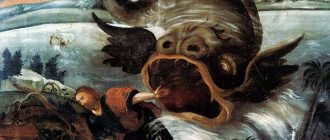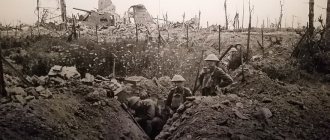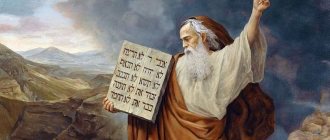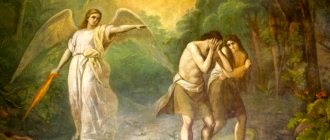From Valaam to the nearest shore - more than 20 kilometers. The climate here is harsh: even in the hottest summer months the temperature rarely rises above 20 degrees, but in winter it is terribly cold, with the wind blowing from the huge Lake Ladoga. In general, Valaam is just the tip, the largest island of the archipelago, which goes deep into the lake. Around the island inhabited by monks there are about 50 smaller islands.
Modern view of Valaam. (valaam.spb.ru)
Getting to Valaam is not at all easy, living there is even harder. Despite this, the first settlements here, according to legend, appeared in the 10th century: there are no sources that would confirm this for sure, but it is believed that a Greek monastery was already located on the island then. The chronicler Nestor in The Tale of Bygone Years even claimed that the first cross on Valaam was erected by Saint Andrew the First-Called himself. There is simply no other written evidence that would shed light on the ancient history of the island.
Sergius and Herman of Valaam
When exactly the Valaam Monastery was founded is also unknown. Sometimes, again guided by ancient legends, its construction is attributed either to the 10th or to the 12th century. It is reliably known that by the beginning of the 15th century an Orthodox monastery already existed. In ancient times, even before the arrival of Christians, the island was chosen by pagans: there is even a version according to which the Finnish name “Valamo” stands for “Land of Veles”.
The founders of the monastery are considered to be Saints Sergius and Herman. Presumably, they were Greeks who found themselves in the vastness of Rus' during the reign of Princess Olga. There is also an opinion among researchers that Sergius could have been a companion of Andrew the First-Called, since the Lord is believed to have traditionally sent the apostles to serve in twos. Be that as it may, the relics of Sergius and Herman are still kept on Valaam “under cover,” that is, in a special storage facility.
“View of Valaam”, Ivan Shishkin. (Wikimedia Commons)
From the moment the Orthodox monastery appeared on Valaam, people from the most distant cities began to come to these northern lands to take a vow of obedience. It is not known for certain who exactly lived on the island in those ancient times, but historians suggest that there was an abbot and brethren in the monastery even then. Saint Abraham of Rostov, who later founded the Epiphany Monastery, also became a monk of the monastery. One of the editions of the life of Abraham of Rostov says that he lived on Valaam back in the 10th century. It was thanks to this mention that the assumption that Orthodox monks settled the island and founded their monastery during the Baptism of Rus' became widespread.
Against foreigners
One of the most striking pages in the military history of Russian monasticism were the events of 1581, described in the “Tale of the Pskov-Pechersky Monastery.” The monks had to fight with the soldiers of the Polish king Stefan Batory, who was besieging Pskov. It is noteworthy that the monks were the first to attack the Lithuanian detachment, which was accompanying carts with looted property and prisoners. “When they reached the Pechersky Monastery, then the monastery people rushed at them and drove them away; All their property was taken away and brought to the monastery,” said the chronicler. The inhabitants of the monastery repeated a similar sortie the next day, and among the captured trophies there was even a live camel. Having learned that more than 30 Poles, Hungarians and Germans were being held captive in the Pskov-Pechersk monastery, the king sent an army to its walls on October 29 under the command of the governors Ketler and Farensbach. On the Russian side, the defense was led by military commander Yuri Nechaev. The foreigners managed to break through the fortress wall and break into the monastery. The priests, monks and “ordinary people” of the monastery (workers and local villagers), having created a prayer service to the icon of the Dormition of the Most Pure Mother of God, “became indestructible, like Mount Zion.” The battle lasted the whole day, and as a result, the Polish-Hungarian detachment had to retreat. The monks captured Voivode Ketler, and Farensbach was wounded. The military leader Bornelissa (Burnamissa) sent by the king also failed to take the monastery. During the enemy attacks, the monastery lost more than 40 people killed and wounded. For foreigners, the participation of monks in the war was something unusual. The Great Crown Hetman Jan Zamoyski, sent by Stefan Batory for negotiations, wrote to the Pskov-Pechersk abbot Tikhon that his monks, “forgetting about their monasticism, flooded the temple of the Lord and the holy place with blood.” However, the brethren themselves were confident that their cause was just. According to legend, during the battle the enemies saw God's help over the monastery - “many warriors in white robes.” Again, the inhabitants of the Pskov-Pechersk monastery had to change their rosary beads to swords 30 years later, during the Time of Troubles. On April 27, 1611, the interventionists of Hetman Khodkevich fired at the monastery from cannons. In retaliation, the monks and laymen, having prayed, launched a foray into enemy fortifications, killed several Poles and captured prisoners. According to the text “Tales of the Invasion of Foreigners on the Pskov-Pechersky Monastery,” many miracles occurred during the siege, which lasted until May 11. During the Time of Troubles, the Trinity-Sergius Lavra also withstood a 15-month siege. But the Joseph-Volokolamsk Monastery was not able to withstand the pressure of the enemy.
Under the onslaught of the Swedes
The island of Valaam was located far enough from any civilization that, as it seems at first glance, should have provided the local residents with a more or less safe existence. In fact, the Orthodox monastery haunted the Swedes: they often carried out devastating raids, after which there was literally nothing left on the island - all the buildings at that time, including the Trinity Valaam Monastery itself, were wooden, so the attackers burned everything that came across them on the way. For example, in the Novgorod chronicles there is a mention that the relics of the founders of the monastery - Sergius and Herman - were transported to Novgorod just during the next invasion of the Swedes, who in the middle of the 12th century decided to rob the peaceful monastery.
“On the Island of Valaam”, Arkhip Kuindzhi. (Wikimedia Commons)
There is practically no evidence of how the monastery lived many centuries ago, but in peacetime, between attacks, famous monks appear on the island: among them the Monk Arseny Konevsky, the founder of the Trinity Monastery on another island of the Valaam archipelago, the hermit Alexander Svirsky, the monk Savva of Solovetsky , who later founded monasticism on the island of the same name.
Life on Valaam went on as usual, but only until the warlike Swedes appeared on the horizon. Once again they destroyed the monastery in 1578, during the persecution of Orthodox Karelians. Then the Swedes killed more than 30 elders and novices who zealously defended the Orthodox faith. A few more years later, another disaster happened on Valaam - a plague epidemic, which wiped out the already not very large population of the island.
Short-lived prosperity
At the very end of the 16th century, the Swedes finally signed a peace treaty with the Russians, and then Tsar Fyodor Ioannovich allocated considerable money from the treasury to restore the monastery on Valaam. This time is the heyday of monasticism on Valaam. His influence was so strong that monks began to found monasteries not only on the island itself, but also beyond its borders - more than a dozen appeared on the coast of Lake Ladoga, near the city of Kexgolm, which is now called Priozersk. Those who moved to the “mainland” made a lot of effort to convert the people who inhabited the Northern Ladoga region to the Orthodox faith.
“Holy Island”, Nicholas Roerich. (sibro.ru)
The serene life on Valaam did not last long: in 1611, the Swedes came again and destroyed the monastery to the ground, and also killed the abbot and brethren who did not want to leave the island. Not a trace remains of the monastery's former glory. The Treaty of Stolbovo assigned these possessions to the Swedes, who in a short time even managed to build housing for themselves on the island. For more than a century, Valaam was occupied by infidels who, of course, did not intend to honor Orthodox traditions.
“The Solovetsky monks have become so accustomed to the military
The Solovetsky Monastery was not only a spiritual center, but also an impregnable military fortress, and they found it possible to ask Tsar Mikhail Fedorovich not to appoint special governors to the Sumy fort for the management and command of the monastery and “arrival archers”, but to leave this matter to the Solovetsky abbot and the brethren , wrote church historian Archpriest John Syrtsov. — In 1637, the last governor, Timofey Krapivin, handed over all written files, prison keys, and all the weapons to the Solovetsky abbot Bartholomew and went to Moscow forever. Now the Solovetsky rector has literally become the “northern governor.” Since 1654, due to the Swedish threat and the small number of archers, the monks themselves had to learn the art of war. A written military “schedule” appeared on Solovki, where responsibilities were distributed among 425 monks placed “under arms”. The elders and their henchmen were “assigned” to different towers with cannons. As a result, the monks not only learned to wield weapons, but also “to a certain extent adopted the spirit of military courage and courage.” And given the religious fanaticism characteristic of many of them, warrior-monks who were not afraid of death were a formidable force. However, instead of fighting the foreigners, the monks soon turned their weapons against the royal archers. Not accepting the reforms of Patriarch Nikon, the Solovetsky Monastery rebelled, and from 1668 to 1676 successfully defended itself against Moscow troops. Only with the help of a 10,000-strong army did voivode Ivan Meshcherinov finally manage to take Solovki. At the same time, almost all the schismatic monks died - out of 700 inhabitants of the monastery, only 14 people survived.
Monarchs patronize monks
While Peter I was pushing back the Swedes during the Northern War, some descendants of those who once lived on Valaam dreamed of returning to the destroyed monastery. This happened right during the war, six years before the peace treaty was signed in 1721. The construction of a new monastery on lands that had literally just been reconquered began, apparently, by personal decree of Peter I. The emperor’s undertakings were continued by Elizaveta Petrovna, who, in turn, allocated a large sum for the improvement of the monastery. The money was used not only for repairs and construction of new buildings, but also for the purchase of necessary church utensils. All undertakings in the mid-18th century were destroyed by a strong fire. After him, Elizaveta Petrovna had to give almost ten times more money than the last time to restore the monastery.
Ancient Valaam. (valaam.spb.ru)
In the history of Valaam, perhaps, two abbots stand out most of all - Nazarius and Damascene. Both of them did everything to ensure that the monastery turned into a famous monastery, a large monastery that almost every Orthodox person dreamed of seeing. Thus, under Nazarius, a stone five-domed cathedral appeared on Valaam, and under him the first monasteries arose - remote places where monks live in small groups. Damascene, later nicknamed “the builder of Valaam,” erected new stone cells and even a hotel for those who came to the island to pray. By the way, there were quite a few of them - their number reached seven to eight thousand a year. Pilgrims from distant cities came to Valaam mainly in the summer, but the residents of the Ladoga region themselves, sometimes without even normal shoes and warm clothes, went straight across the lake in winter in the hope of receiving alms and living for a few days near the monastery.
New chapels and worship crosses arose in different places on the island: rich people from all over the Russian Empire willingly donated money for the development of the monastery. The brethren grew, and the Valaam monastery itself was considered one of the most comfortable in the country. A brick, tar and tannery, a cattle yard and a grain barn appeared on the island. The calm and peaceful life of the monastery continued until a political revolution took place in Russia.
TOP 10 Russian holy warriors (Part one)
The Russian land has long been famous for the military spirit and prayerful zeal of its sons. It often happened that exploits on the battlefield and exploits for the glory of God were intertwined in the life of one person.
We honor the warriors who were most successful not only in defending the Motherland, but also in pleasing God as saints. Today we propose to remember the Russian holy warriors and their great achievements:
1. Holy Equal-to-the-Apostles Grand Duke Vladimir Svyatoslavich
We all know that it is to the wise Prince Vladimir that we owe both our faith and our great culture.
In his youth, Prince Vladimir was a pagan and often acted cruelly and ignoblely. But, having learned the true faith, he went through deep internal changes, began to pray regularly, do a lot of charity, build temples and found princely schools in the cities of Rus'.
Thanks to his baptism and the conversion of the country to Orthodoxy, the holy prince was able to conclude an alliance with Byzantium, the most powerful and cultural state of his time, and married the sister of the Byzantine emperor, Princess Anna.
But the Lord favored the saint on the military path: the prince seriously strengthened and expanded the state he inherited, annexing to it the lands of the Vyatichi and Radimichi, the rich cities of Cherven and Przemysl on the border with Poland, the lands of the Yatvingians on the shores of the Baltic Sea and the lands of the White Croats in the Carpathian region. .
In addition, Saint Vladimir managed to calm down the restless eastern neighbors from the Great Steppe, who had previously bothered them with constant predatory raids: in several campaigns he defeated the Volga Bulgars and Khazars and concluded a profitable peace, imposing tribute on the nomads.
For his apostolic activity, pious life after baptism and concern for the welfare and safety of his subjects, the Church canonized Prince Vladimir.
2. Venerable Elijah of Muromets
The saint lived in the 12th century. He came from a simple peasant family and, as epic sources say, in childhood and youth he suffered from paralysis, but was miraculously healed through the prayer of wanderers.
Having gained health, he decided to take the path of military service, joined the squad of the Kyiv prince and for many years guarded the borders of Rus', where he became famous for his military exploits and unprecedented strength.
Little reliable information about his life has been preserved, but his exploits served as the basis for a whole cycle of Russian epics and German epics.
In his old age, the hero Elijah entered the Kiev-Pechersk Monastery, where he took monastic vows and spent his last years in spiritual exploits. He died, most likely, in the late 80s of the 12th century.
In 1643, the Monk Elijah of Muromets was officially canonized among sixty-nine other saints of the Kiev Pechersk Lavra. The Russian army has long considered the holy hero their patron.
3. Reverend Grand Duke Dmitry Donskoy
The name of this saint is associated with an event no less important for the history of Russia than the baptism of our country - liberation from the almost 250-year-old Tatar-Mongol yoke.
The Grand Duke of Moscow moved from internecine warfare with other Russian princes to concerns about the interests of the entire Fatherland. Busy with collecting Russian lands, Grand Duke Dimitri managed to assemble a coalition of Russian principalities against the Tatar army of Mamai, who threatened another ruin of Rus'.
This was a difficult decision, because the Russian army did not know any major victories over the Tatars before the Kulikovo Field. Prince Dimitri even went for advice and blessings to the holy Venerable Sergius of Radonezh, who assured him of his prayerful support and gave him two monks of his monastery to help.
As a result, Russian armies under the leadership of Prince Dimitri defeated Mamai's horde on the Kulikovo field and thereby marked the beginning of liberation from the Tatar threat and the restoration of a unified national Russian state. For his victory, the prince received the nickname “Donskoy”.
4. Rev. Alexander Peresvet
The Monk Alexander Peresvet was one of two monks who, with the blessing of their abbot, the Monk Sergius of Radonezh, as an exception (church rules prohibit persons of clergy from fighting), took part in the Battle of Kulikovo.
Before becoming a monk, both schema-monks were warriors and served in princely squads, and their presence on the battlefield, according to the thought of St. Sergius, was supposed to inspire the Russian army.
Before the start of the battle, he entered into single combat with the Tatar fighter Chelubey, who, according to legend, mastered occult magical practices and could instill fear in any opponent.
But in a fight with an Orthodox monk, who did not even put on armor, remaining in the schema, this did not help him. After the collision, both fighters fell dead, but Chelubey was knocked out of the saddle towards the enemy, which was considered an undoubted victory for Peresvet.
5. Rev. Andrei Oslyabya
The second schemamonk from the Trinity-Sergius Lavra, who fought on the Kulikovo field. Like Alexander Peresvet, Andrei Oslyabya fought without armor in his monastic robes.
He, by lot cast between two monks, fell to be in battle near Prince Dmitry Donskoy and protect him from the Tatar sabers. The Monk Andrew completed his task to the end and fell in battle, but Prince Demetrius, thanks to his help, managed to survive.
Before becoming a monk, Andrei Oslyabya was a noble boyar and a professional military man. Presumably, he even commanded a thousand Moscow troops in the Drunken Massacre.
The second part of the TOP
Andrey Szegeda
You can applaud the author (at least 10 times)79
Unenviable fate
Valaam, the center of Orthodoxy, suddenly became part of Finland, which declared independence in 1917. The thing is that under the tsar the island belonged specifically to the Grand Duchy of Finland, so it, like other territories, had to be given away. At this time, the monastery, which the Finnish authorities largely ignored, became a refuge for emigrants who dreamed of the revival of that very “old Russia”. A shelter for children from Karelia was opened on the island, and services began to be held in Finnish. Sometimes groups of pilgrims came to the monastery - now not as numerous as before - but not from Soviet Russia, but from Finland and Estonia.
Pilgrims on Valaam. (pravoslavie.ru)
In predominantly Lutheran Finland, Valaam still found its place, remaining an important point for all who adhered to the Orthodox faith. The Soviet leadership, which unleashed the Winter War with Finland and annexed these lands to the USSR, had a completely different attitude - the elders were left no choice. During the war itself, the island was repeatedly bombed; the abbot of the monastery even noted in his notes that the bells of Valaam had long ceased to call anyone to prayer, their ringing only foreshadowed another airplane raid. During the hostilities, almost the entire brethren were evacuated from the island to Finland: Valaam was empty, there were only a few people left there who were supposed to look after the economy.
In 1940, the entire Valaam archipelago passed to the Soviet Union. Without hesitation, the military occupied the holy place and created a boatswain school there. Now it was not pilgrims who came to the island, but young cadets. In 1944, during the Great Patriotic War, the monks were able to visit their native monastery for the last time. On the island, right in the monastery buildings, the Valaam Home for the Invalids was opened, where until the mid-1980s they received soldiers who suffered during the war.
In the imperial army
It should also be mentioned that in the 18th century the institution of military clergy emerged in the Russian imperial army. It also included hieromonks—priests who had taken monastic vows. In the navy, they even became the predominant category of priests, since they were not related to family and could participate in long sea voyages. The “black” military clergy existed in Russia until the First World War. Some examples of the military valor of army hieromonks can be found on the pages of the magazine “Bulletin of the Military and Naval Clergy” dated October 1, 1916. At the front in the Vilna province, the regimental priest of the 276th Kupyansky infantry regiment, Hieromonk Anatoly, voluntarily went on reconnaissance on the night of July 29 in order to encourage and reassure the soldiers with his presence. However, near the enemy's wire fences, the hieromonk was seriously wounded by an explosive bullet in the thigh, damaging the bone. For this feat, the authorities nominated Father Anatoly to the Order of St. Vladimir, 4th degree. Summing up, it is difficult to disagree with the words of the Athonite monk, abbot Alexy (Prosvirnin), who sees in warrior monks a combination of “worldly warfare” and “spiritual warfare” in their highest manifestations.
Magazine: Mysteries of History No. 43, October 2021 Category: Religions of the World Author: Timur Sagdiev
Tags: Mysteries of history, Rus', Patriotic War, Orthodoxy, Battle of Kulikovo, fortress, monastery, Dmitry Donskoy, Time of Troubles, defense, Solovki
- Back
- Forward
